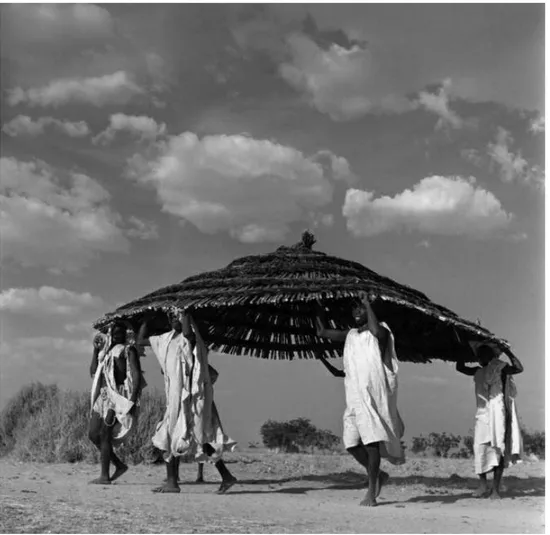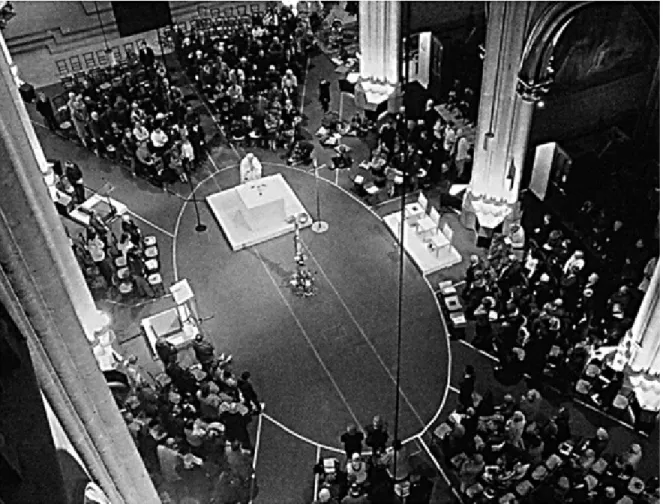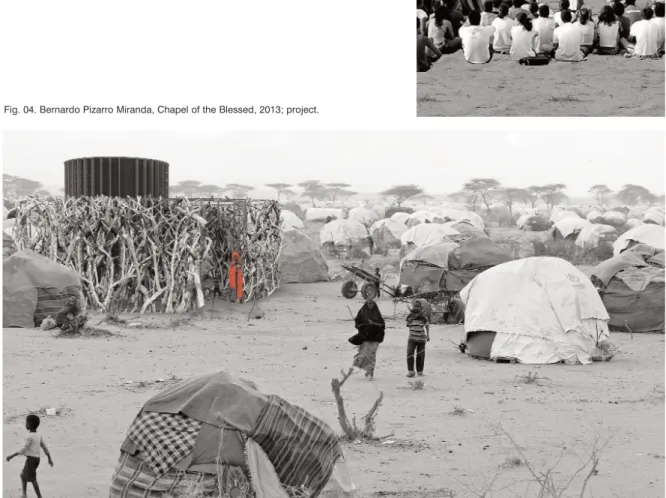Bernardo Pizarro Miranda · ISCTE-IUL Departamento de Arquitectura e Urbanismo. CIES (Lisboa, Portugal)
RESUMEN
The Second Vatican Ecumenical Council aimed, in the words used by Pope John XXIII, the aggiornamento of the Catholic Church. The inseparable complementariness between the concept of resourcing and of openness to a new world led to a change of the paradigm of the church temple to the house for the living stones. It is in this context where it comes to light the opportunity to explore the contributions of two non-Christians architects: Aldo van Eyck, and Lina Bo Bardi. In their works and especially in their thoughts it is possible to recognize an elective affinity with the spirit of the Christian aggiornamento.
PALABRAS CLAVE
Historical Present, House of the Living Stones, Active Participation.
ABSTRACT
El Concilio Ecuménico Vaticano II buscó —en las palabras utilizadas por el Papa Juan XXIII— el aggiornamento de la Iglesia Católica. La complementariedad inseparable entre los movimientos de refontalización y de apertura a un nuevo mundo dio lugar al cambio de paradigma del templo eclesial a la casa de las piedras vivas. Es en este contexto en el que entendemos la opor-tunidad de explorar las contribuciones de dos arquitectos no cristianos: Aldo van Eyck y Lina Bo Bardi. En sus obras —y espe-cialmente en sus pensamientos— es posible reconocer una afinidad electiva con el espíritu del aggiornamento cristiano.
KEYWORDS
THE SPIRIT OF THE CATHOLIC AGGIORNAMENTO: ARCHITECTURE, DIALOG AND ACTIVE PARTICIPATION
THE HISTORICAL PRESENT
In December 8th 1965 ended the Second Ecumenical Council of the Catholic Church (1962/65) at the Vatican City State. The meeting aimed, in the words used by Pope John XXIII, the aggiornamento of the Catholic Church. A new perception of the world and the purpose to adapt the tradition of the Church to the new conditions of our time, led to a change of the par-adigm of the church temple to the house for the people of God.
In the foreword to the French translation of the Cardinal J.H. Newman (1801/90) sermons Le secret de la prière, Louis Bouyer writes in 1958: «Newman is the living example of a return to the sources that is being tal-ked about so much these days and this should be, for the Christians, the secret of the unique modernity independ-ent from any time changes: This or the essindepend-ential, the eternal part of the faith, is endlessly renewed because we find it in its Spring and express it always in the same manner, directly to its contemporaries» (Gy 1995, 36).
Pierre-Marie Gy (1922-2004) relates the words of Newman to another formula from Yves Congar (1904/95), where the latter says: «The Christian tradi-tion is the presence of a beginning in all its history (...) We could compare the tradition to a river that outpours from a fountain and immerses numerous countries; or also to a tree that grows and bears branches loaded with fruits: The more it rises towards the sky, the more it needs to cling to its roots» (Gy 1995, 36). Both formu-las summoned by Pierre-Marie Gy reinforce the belief that one of the most important ideas of the Second Vatican Council is the inseparable complementariness between the concept of resourcing and of openness to a new world. The interdependency between these two concepts is opposed to a conception merely static of tra-dition. For Gy, the liturgical reform of the Second Vatican Council has, by its very nature, a place in the correlation between the time of the events and the time
faster than before, nor can these change any faster» (Gy 1995, 43).
The relationship between the religious and philoso-phical concepts and the theoretical speech on architec-ture of the 20th Century has in itself the opportunity for an investigation. The emergence of a new thinking on religious architecture is also a consequence of the investigation made regarding the writings and works of non-Christian authors that met, in the 20th Century, the programmes and practices of the religious architecture of Christian tradition.
It is in this context that it comes to light the oppor-tunity to explore the contributions of two non-Christians architects: Aldo van Eyck (1918/99) and Lina Bo Bardi (1914/92). In their works as in their words it is possible to recognize an elective affinity with the spirit of the aggiornamento set out at the Second Vatican Council. We need to understand the past in the light of the historical present, repeatedly said Lina Bo Bardi: «When facing the historical present, our task is to give shape to a new present, a true one, and to do so we do not need to have the deep knowledge of a specialist, but rather the ability to understand histori-cally the past, to know how distinguish what will be of use for today’s events. (...) In fact, the past does not exist, what exists is the historical present» (Rubino and Grinover 2009, 165).
The historical present, which is as unpredictable as the wind that blows wherever it wants, is opposed to a tradition built based on an exclusive interpretation of the history of man, of the architecture or of the Church. To freeze history, to Lina Bo Bardi, is the same as «to coerce an epoch by imposing it embalmings of plas-ter and cardboard, it means to ignore the tiring and painful progress of mankind that the incompetence, the dilettantism and the ignorance reverse by kilometres each centimetre it manages to conquer forward» (Ferraz 2008, 11).
Fig. 01. Aldo van Eyck, Otterlo Circles Diagram, 1959.
Fig. 02. Men leaving Kano market (Nigeria) carrying their latest purchase: a new roof for their house, 1951.
and vernacular. The way he presents them, using a dia-gram that would become known as «Otterlo circles» (Fig. 01), implies the consideration that these three tra-ditions should reconcile with each other in order to develop an architecture with a potential rich enough to face the complex reality of the contemporary life (Strauven and Ligtelijn 2008, 2). To the concept of clas-sical, he associates the scheme of Parthenon, evoking the ideas of immutability and rest. To the concept of modern, he associates a project of Theo van Doesburg (1883-1931), evoking the ideas of change and move-ment. And lastly, to the concept of vernacular of the heart he associates the plan of a small village in the Algerian dessert evoking the idea of collective beha-viour. The first circle, related to the phrase «By Us» articulates with a second circle which he identifies with the phrase «For Us». In this last circle, Van Eyck places the image of a tribal dance of the Indians Caiapó; a group living in the Brazilian Amazon. In the cyclic movement of the dance, Van Eyck identifies the idea that architecture deals with a complex and constant pro-cess of transformation of the human reality, i.e., «not only with what it is different from the past, but also with what remained the same» (Strauven 1998, 2).
Each place, each circumstance, each object, results of the transformation of other places, other circumstan-ces and other objects, in a cyclical continuum. The Caiapó dance, the codomain of the three traditions, pla-ces architecture face to face with the invisible, overco-ming the simple construction of circumstantial rela-tionships. This domain is, for van Eyck, the starting point to understand architecture as an art to build places to the homecoming: the home, we add, of interiority, of hospitality, of community.
THE HOUSE OF THE LIVING STONES
In an article of 1972, the Jesuit priest Antonio Lopes (1926-2007) recalls the dream of Karl Rahner
THE SPIRIT OF THE CATHOLIC AGGIORNAMENTO: ARCHITECTURE, DIALOG AND ACTIVE PARTICIPATION
the priority of the house for the living assembly, the place for the openness to the Other, endlessly close and endlessly different.
Understood by Philip Markiewicz as the centre line between the body and the cosmos, transforming the Earth in a habitable place, the architecture enables the retirement or the shelter of the world. It is the «place of this proximity (...), the alterity or the meaning of things, the Other» (Markiewicz 2006, 6-9).
The idea of a construction without a physical des-cription, as opposed to what happened to the Jerusalem temple —thoroughly described in Exodus 26— is pro-bably the biggest idiosyncrasy of the Christian locus.
The planning and statics of a building built with living stones remains, in its indetermination, a mystery (Fig. 02).
The same mystery of the words of Lina Bo Bardi who, at the end of the Second World War, states: «It was when the bombs demolished the buildings, and the buildings made by men, that we understood that the house must exist for the life of Man, it must serve, it must comfort; it must not reveal, in a theatrical display, the useless vanities of the human spirit» or even «the home is who inhabits it, it is man himself» (Ferraz 2008, 10).
In the small church conceived by Aldo van Eyck for the Moluccan community in Deventer (The Netherlands, 1986/92) and in the church of Espírito Santo do Cerrado conceived by Lina Bo Bardi in Uberlandia (Brazil, 1976/82), echoes the poetic expres-sion of Markiewicz: «I like to let the old walls talk. Each stone, in its place, bears the plan of the architect. It achieves nobility by its placement in the building; but this added value comes from the initial qualities of wild stone of which it remains fully dependant. Besides, has it ever been a completely wild stone? I cannot stop thin-king of the creation of the World, this Plan that was before all plans. The raw material is not an absolute
THE SPIRIT OF THE CATHOLIC AGGIORNAMENTO: ARCHITECTURE, DIALOG AND ACTIVE PARTICIPATION
primacy of the assembly, the primacy of men over the object . The idea of a temple, or of an exceptional buil-ding, meets in the metaphor of the spiritual home the catalyst of a new orientation. The return of the designa-tion of the word church to the reunion of men around the idea of participation in the construction of a supe-rior unity is perhaps one of the marks of the 20th Century religious architecture.
ACTIVE PARTICIPATION
Joseph Gelineau (1920-2008), a Jesuit priest who participated in the process of the liturgical readjustment of the church of St. Ignatius in Paris (Fig. 03), has devo-ted much of his investigation to the theme of the liturgi-cal assembly and to the idea of the active participation in the celebration, two of the major aspects of the reform conceived in the Second Vatican Council. In a text, inte-grated in the magazine Espace. Eglise, art et architectu-re1, under the title Quand les hommes se rassemblent,
Gelineau places himself before the complex problematic of the creation of a space for the celebrant assembly.
In a time of reforms and of ressourcement such as ours —Gelineau states— the temptation is to go back to the ancient forms understood as more pure, simpler and more authentic. However, he thinks, this is a simplistic vision of the problem. Nowadays it is not only neces-sary, but desirable, to search for more significant ways to refer to the human gestures and behaviours that give meaning to the rites, questioning through the historical present, the process of creation of a space for the litur-gical assembly.
The way how we place ourselves before this pro-blematic, without running out its complexity, through a set of questions elaborated by Gelineau (1985, 23), aims to propose a reflection to be developed:
—If the liturgical assembly, small or large, consti-tutes the first symbol of all celebration, in what way does space enables this kind of meeting?
—How do the present assemblies perceive (positi-vely or negati(positi-vely) the unquestionable exercise of a power, revealed, in space, the excessive bipolarization between the ministers of the cult and the rest of the community?
—Is the shared meal, in fact, the greatest symbol of the Christian cult? How can we make intelligible its symbolic dimension in liturgy when the disposition of the assembly in the Eucharist remains identical to the celebration of the Word; when the scale of the altar and of its placement evokes more the scenographic form than the shared meal or, as Gelineau questions, «when the preparation of the table for the meal is reduced to a set of mechanical gestures, almost practical?»
In November 2013, the 3rd International Conference on Contemporary Religious Architecture was held under the theme Beyond the sacred building: architecture and evangelization. The conference embraced a new model of participation, confirming the exercise of architecture as a territory of investigation. The challenge consisted in thinking and planning a small space of silence and pra-yer, adjustable to several urban circumstances. This place should foresee the possibility of receiving several kinds of celebration, with a program that we understood as open to ecumenicism. It should value the polyvalen-ce, the mobility of the construction, as well as its iconic ability, rethinking the place of the religious architecture in the contemporary world.
Our proposal, thought in the form of a project (Fig. 04), reflected the doubts and the restlessness we felt as we approached these final considerations: «A place for quiet and silence. Can an object question human indif-ference? The metaphor of the world’s assembly?» (Miranda 2013).
To conceive and to draw places for interiority, for hos-pitality and for community, open to the other, endlessly different but endlessly close, should fit the immeasurable love of the Christ who, in the thought of Pier Paolo
THE SPIRIT OF THE CATHOLIC AGGIORNAMENTO: ARCHITECTURE, DIALOG AND ACTIVE PARTICIPATION
NOTES
(1) Quarterly magazine, founded in 1977, published under the supervision of the French National Board for Sacred Art, issued by the Portuguese National Center of Liturgical Pastoral (CNPL). Its publication ended in 1983. The members of the editorial board were, amoung others, Joseph Gelineau, Jean-Yves Hameline (1931-2013) and Pierre-Marie Gy.
BIBLIOGRAPHY
Ferraz, Marcelo Carvalho, ed. 2008. Lina Bo Bardi. Sao Paulo: Instituto Lina Bo e P.M. Bardi, Imprensa Oficial.
Gelineau, Josep. 1977. «Quand les hommes se ras-semblent». Espace. Eglise, arts, architecture 1:18-25.
Gy, Pierre-Marie. 1995. «Liturgia da Igreja, tradi-ção viva e Vaticano II». Boletim de Pastoral Litúrgica, 78-80:35-43. Avaliable online at www.liturgia.pt/files/ bpl/bpl078-080.pdf.
Lopes, António. 1972. Pequenas comunidades e novo rosto da Igreja. Lisboa: [s.e.]
Markiewicz, Philippe, and Ferrante Ferranti. 2005. Les Pierres vivantes. L'église revisitée. Paris: Philippe Rey.
Markiewicz, Philippe. 2006. «Aller vers l’espace sacramental». Chroniques d’Art Sacré 87:6-9.
Miranda, Bernardo, et al. 2013. «Un pequeño espacio de silencio y oración». Actas del Congreso Internacional de Arquitectura Religiosa Contemporá-nea 3:298-311.
Pasolini, Pier Paolo. 2005. Pasiones heréticas (Correspondencia 1940-1975). Buenos Aires: El Cuenco de Plata.
Rubino, Silvina, and Marina Grinover, compilers. 2009. Lina por escrito. Textos escolhidos de Lina Bo Bardi. São Paulo: Cosac Naify.
Strauven, Francis, and Vincent Ligtelijn, compilers. 2008. Aldo van Eyck. Writings (vol I). Rotterdam: Sun. Strauven, Francis. 1998. Aldo van Eyck: the shape of relativity. Amsterdam: Architectura & Natura. SOURCE OF FIGURES
Fig. 01. Strauven and Ligtelijn 2008. Fig. 02. George Rodger (Magnum Photos). Fig. 03. Chroniques d’Art Sacrè 87 (2006). Fig. 04. Actas del Congreso Internacional de Arquitectura Religiosa Contemporánea 3 (2013), www.arquitecturareligiosa.es/index.php/AR/issue/view/5.


